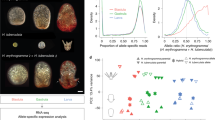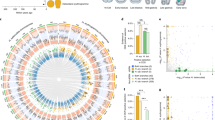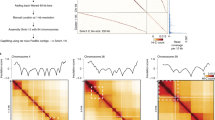Abstract
WE reported recently on the properties of the deoxyribonucleic acids isolated from the egg, sperm and adult diploid tissues of the American sea urchin, Arbacia punctulata1. It was found that the DNA isolated from the two haploid cells had similar buoyant densities of 1.700 g/cm3. This can be taken to mean that the DNAs from these sources have identical base compositions2. On the other hand, the DNA derived from adult diploid cells exhibited a buoyant density of 1.702 g/cm3. If this difference in the density values of the haploid and adult diploid cells reflects a real shift in base composition, it is indeed a most unexpected finding. The current ideas concerning cellular development and differentiation are based on the belief that just as the adult diploid cells derive from the original zygote by orderly mitotic division, so the DNA from the adult cell is derived from the fertilized egg by exact replicative cycles. Because the DNAs of sperm and egg have identical base compositions, this belief would lead to the prediction that a diploid cell resulting from this union would contain DNA with a correspondingly identical base composition. Implied in this concept is the hypothesis that cellular differentiation is not the result of changes in the DNA but rather that it is controlled by histone-masking and/or “cytoplasmic regulators” which have now been equated with messenger RNA.
This is a preview of subscription content, access via your institution
Access options
Subscribe to this journal
Receive 51 print issues and online access
$199.00 per year
only $3.90 per issue
Buy this article
- Purchase on Springer Link
- Instant access to full article PDF
Prices may be subject to local taxes which are calculated during checkout
Similar content being viewed by others
References
Carden, G. A., III, Rosenkranz, S., and Rosenkranz, H. S., Nature, 205, 1338 (1965).
Schildkraut, C. L., Marmur, J., and Doty, P., J. Mol. Biol., 4, 430 (1962).
Bibring, T., Brachet, J., Gaeta, F. S., and Graziosi, F., Biochim. Biophys. Acta, 108, 644 (1965).
Gross, P. R., Malkin, L. I., and Moyer, W. A., Proc. U.S. Nat. Acad. Sci., 51, 407 (1964).
Temin, H. M., Proc. U.S. Nat. Acad. Sci., 52, 323 (1964); Virology, 23, 486, (1964); Health Lab. Sci., 1, 79 (1964). Bader, J. P., Virology, 22, 462 (1964); Virology, 26, 253 (1965); Science, 149, 757 (1965).
Comb, D. G., J. Mol. Biol., 11, 851 (1965).
Kit, S., J. Mol. Biol., 3, 711 (1961); Nature, 193, 274 (1962).
Schurin, M., and Marmur, J., Abst. Papers First Ann. Meet. Amer. Soc. Cell. Biol., 193 (1961). Rosenkranz, H. S., unpublished results.
Dawid, I. B., J. Mol. Biol., 12, 581 (1965).
Lipsky, D., and Rosenkranz, H. S., Biol. Bull., 129, 413 (1965).
Mazia, D., and Plaut, W. S., Biol. Bull., 100, 335 (1955). Plaut, W., and Mazia, D., J. Biophys. Biochem. Cyt., 2, 573 (1956).
Spemann, H., Z. Wiss. Zool., 132, 105 (1928).
Seidel, F., Wilhelm Roux' Arch. Entwicklungsmech. Organ., 126, 213 (1932).
Briggs, R., and King, T. J., in Biological Specificity and Growth (edit. by Butler, E.), 207 (Princeton University Press, 1955). King, T. J., and Briggs, R., Proc. U.S. Nat. Acad. Sci., 41, 321 (1955).
Baltzer, F., Harding, C., Lehman, H. E., and Boff, P., Rev. Suisse Zool., 61, 402 (1954). Baltzer, F., and Bernhard, M., Exp. Cell Res. Suppl., 3, 16 (1955).
Daly, M. M., Alfrey, V. G., and Mirsky, E., J. Gen. Physiol., 33, 497 (1950). Chargaff, E., Lipshitz, R., and Green, C., J. Biol. Chem., 195, 155 (1952).
Wecker, E., Virology, 7, 241 (1959).
Marmur, J., J. Mol. Biol., 3, 208 (1961).
Author information
Authors and Affiliations
Rights and permissions
About this article
Cite this article
ROSENKRANZ, H., CARDEN, G. DNA during the Development of the American Sea Urchin. Nature 213, 1024–1025 (1967). https://doi.org/10.1038/2131024a0
Issue Date:
DOI: https://doi.org/10.1038/2131024a0
Comments
By submitting a comment you agree to abide by our Terms and Community Guidelines. If you find something abusive or that does not comply with our terms or guidelines please flag it as inappropriate.



